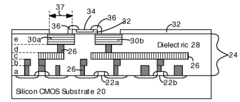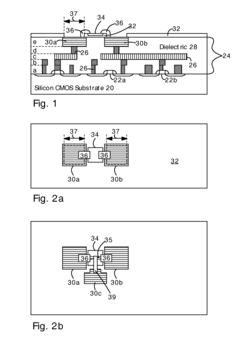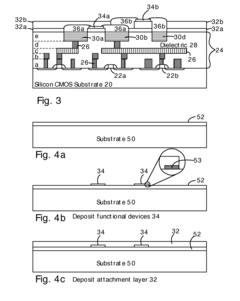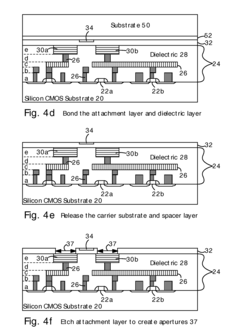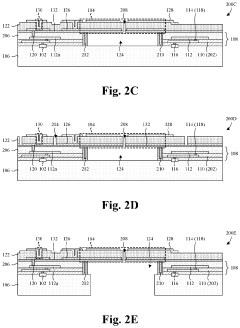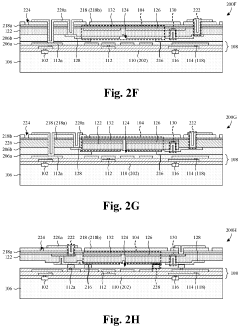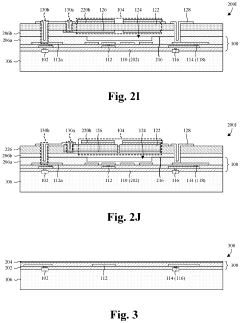How CMOS Battery Supports Wearable Fitness Devices?
JUL 22, 20259 MIN READ
Generate Your Research Report Instantly with AI Agent
Patsnap Eureka helps you evaluate technical feasibility & market potential.
CMOS Battery Evolution
The evolution of CMOS batteries in wearable fitness devices has been a critical factor in the rapid advancement of this technology sector. Initially, these devices relied on traditional button cell batteries, which limited their functionality and required frequent replacements. The introduction of CMOS (Complementary Metal-Oxide-Semiconductor) technology marked a significant turning point in the power management of wearable fitness devices.
CMOS batteries, also known as RTC (Real-Time Clock) batteries, were first integrated into wearable fitness devices in the early 2010s. These small, rechargeable lithium-ion batteries provided a constant power source for maintaining essential functions such as timekeeping and data retention, even when the main battery was depleted or removed. This innovation allowed for more reliable and continuous operation of fitness tracking features.
As wearable technology advanced, so did the capabilities of CMOS batteries. Manufacturers began to develop more efficient CMOS designs that could support additional low-power functions beyond timekeeping. This evolution enabled fitness devices to maintain basic sensor readings and even limited data processing during periods of low main battery charge, ensuring uninterrupted tracking of vital health metrics.
The mid-2010s saw a shift towards integrated power management systems in wearable fitness devices. CMOS batteries were combined with advanced power controllers and energy harvesting technologies. This integration allowed for more intelligent power distribution, extending the overall battery life of the devices and enabling more sophisticated features to operate for longer periods.
Recent developments in CMOS battery technology have focused on miniaturization and increased energy density. These advancements have allowed for the creation of smaller, more lightweight wearable fitness devices without compromising on functionality or battery life. Some cutting-edge designs now incorporate flexible CMOS batteries that can conform to the shape of the device, further enhancing wearability and user comfort.
The latest generation of CMOS batteries in wearable fitness devices has also seen improvements in charging efficiency and cycle life. Many modern devices now feature fast-charging capabilities for both the main and CMOS batteries, reducing downtime and improving user experience. Additionally, enhanced durability and longer cycle lives mean that these batteries can maintain their performance over extended periods, aligning with the increasing longevity of wearable devices.
Looking forward, the evolution of CMOS batteries in wearable fitness devices is expected to continue, with a focus on sustainability and integration with emerging technologies. Research is underway to develop eco-friendly CMOS battery materials and to explore the potential of combining CMOS technology with other power sources, such as solar cells or kinetic energy harvesters, to create even more efficient and self-sustaining wearable fitness devices.
CMOS batteries, also known as RTC (Real-Time Clock) batteries, were first integrated into wearable fitness devices in the early 2010s. These small, rechargeable lithium-ion batteries provided a constant power source for maintaining essential functions such as timekeeping and data retention, even when the main battery was depleted or removed. This innovation allowed for more reliable and continuous operation of fitness tracking features.
As wearable technology advanced, so did the capabilities of CMOS batteries. Manufacturers began to develop more efficient CMOS designs that could support additional low-power functions beyond timekeeping. This evolution enabled fitness devices to maintain basic sensor readings and even limited data processing during periods of low main battery charge, ensuring uninterrupted tracking of vital health metrics.
The mid-2010s saw a shift towards integrated power management systems in wearable fitness devices. CMOS batteries were combined with advanced power controllers and energy harvesting technologies. This integration allowed for more intelligent power distribution, extending the overall battery life of the devices and enabling more sophisticated features to operate for longer periods.
Recent developments in CMOS battery technology have focused on miniaturization and increased energy density. These advancements have allowed for the creation of smaller, more lightweight wearable fitness devices without compromising on functionality or battery life. Some cutting-edge designs now incorporate flexible CMOS batteries that can conform to the shape of the device, further enhancing wearability and user comfort.
The latest generation of CMOS batteries in wearable fitness devices has also seen improvements in charging efficiency and cycle life. Many modern devices now feature fast-charging capabilities for both the main and CMOS batteries, reducing downtime and improving user experience. Additionally, enhanced durability and longer cycle lives mean that these batteries can maintain their performance over extended periods, aligning with the increasing longevity of wearable devices.
Looking forward, the evolution of CMOS batteries in wearable fitness devices is expected to continue, with a focus on sustainability and integration with emerging technologies. Research is underway to develop eco-friendly CMOS battery materials and to explore the potential of combining CMOS technology with other power sources, such as solar cells or kinetic energy harvesters, to create even more efficient and self-sustaining wearable fitness devices.
Wearable Fitness Market
The wearable fitness market has experienced explosive growth in recent years, driven by increasing health consciousness and technological advancements. This segment encompasses a wide range of devices, including smartwatches, fitness trackers, and specialized sports monitors, all designed to help users track their physical activities and health metrics.
Market research indicates that the global wearable fitness market was valued at approximately $30 billion in 2020 and is projected to reach over $100 billion by 2027, with a compound annual growth rate (CAGR) of around 15%. This robust growth is fueled by several factors, including rising health awareness, increasing disposable incomes, and the growing popularity of fitness-oriented lifestyles.
The COVID-19 pandemic has further accelerated market growth, as consumers have become more health-conscious and interested in monitoring their vital signs. This trend has led to increased demand for devices that can track not only physical activity but also metrics such as heart rate, blood oxygen levels, and sleep patterns.
Key players in the wearable fitness market include established technology giants like Apple, Samsung, and Fitbit (now part of Google), as well as specialized fitness companies like Garmin and Polar. These companies are continuously innovating to offer more advanced features and improve user experience, driving market competition and technological progress.
Consumer preferences in the wearable fitness market are evolving rapidly. While basic step counting and calorie tracking remain popular features, users are increasingly demanding more sophisticated functionalities. These include GPS tracking, heart rate monitoring, ECG capabilities, and even stress management tools. The integration of artificial intelligence and machine learning algorithms is enabling these devices to provide more personalized insights and recommendations to users.
The market is also witnessing a shift towards more stylish and customizable designs, as consumers seek devices that can seamlessly transition from workout sessions to everyday wear. This trend has led to collaborations between technology companies and fashion brands, resulting in more aesthetically pleasing and versatile wearable fitness devices.
Looking ahead, the wearable fitness market is poised for continued growth and innovation. Emerging technologies such as advanced sensors, improved battery life, and enhanced data analytics capabilities are expected to drive the next wave of product development. Additionally, the integration of wearable fitness devices with broader health ecosystems, including telemedicine platforms and electronic health records, presents significant opportunities for market expansion and improved health outcomes.
Market research indicates that the global wearable fitness market was valued at approximately $30 billion in 2020 and is projected to reach over $100 billion by 2027, with a compound annual growth rate (CAGR) of around 15%. This robust growth is fueled by several factors, including rising health awareness, increasing disposable incomes, and the growing popularity of fitness-oriented lifestyles.
The COVID-19 pandemic has further accelerated market growth, as consumers have become more health-conscious and interested in monitoring their vital signs. This trend has led to increased demand for devices that can track not only physical activity but also metrics such as heart rate, blood oxygen levels, and sleep patterns.
Key players in the wearable fitness market include established technology giants like Apple, Samsung, and Fitbit (now part of Google), as well as specialized fitness companies like Garmin and Polar. These companies are continuously innovating to offer more advanced features and improve user experience, driving market competition and technological progress.
Consumer preferences in the wearable fitness market are evolving rapidly. While basic step counting and calorie tracking remain popular features, users are increasingly demanding more sophisticated functionalities. These include GPS tracking, heart rate monitoring, ECG capabilities, and even stress management tools. The integration of artificial intelligence and machine learning algorithms is enabling these devices to provide more personalized insights and recommendations to users.
The market is also witnessing a shift towards more stylish and customizable designs, as consumers seek devices that can seamlessly transition from workout sessions to everyday wear. This trend has led to collaborations between technology companies and fashion brands, resulting in more aesthetically pleasing and versatile wearable fitness devices.
Looking ahead, the wearable fitness market is poised for continued growth and innovation. Emerging technologies such as advanced sensors, improved battery life, and enhanced data analytics capabilities are expected to drive the next wave of product development. Additionally, the integration of wearable fitness devices with broader health ecosystems, including telemedicine platforms and electronic health records, presents significant opportunities for market expansion and improved health outcomes.
CMOS Battery Challenges
CMOS batteries, while crucial for wearable fitness devices, face several significant challenges that impact their performance and adoption. One of the primary issues is the limited energy density of CMOS batteries compared to other battery technologies. This constraint restricts the operational time of wearable devices between charges, potentially affecting user experience and device functionality.
The miniaturization of wearable fitness devices presents another hurdle for CMOS batteries. As these devices become smaller and more compact, the available space for batteries decreases. This size limitation forces manufacturers to balance battery capacity with device form factor, often resulting in compromises on battery life or device features.
Temperature sensitivity is a notable concern for CMOS batteries in wearable fitness devices. These devices are frequently exposed to varying environmental conditions and body heat during use. Extreme temperatures can significantly impact battery performance, potentially leading to reduced capacity, shortened lifespan, or even safety issues in severe cases.
The charging efficiency of CMOS batteries also poses challenges. Wearable fitness devices often require frequent charging due to their continuous use and limited battery capacity. The charging process needs to be fast and efficient to minimize downtime, but rapid charging can lead to increased heat generation and potential degradation of the battery over time.
Durability and longevity are critical factors for CMOS batteries in wearable devices. The constant movement and potential impacts experienced by these devices can stress the battery components. Ensuring that the battery maintains its performance and capacity over an extended period of use is essential for consumer satisfaction and device reliability.
Power management is another complex challenge. Wearable fitness devices often incorporate various sensors and features that require different power levels. Efficiently managing power distribution while maintaining optimal performance across all device functions is a delicate balancing act for CMOS battery systems.
Safety concerns are paramount, especially given the close proximity of these devices to the human body. CMOS batteries must be designed to prevent overheating, swelling, or leakage, which could pose risks to users. Implementing robust safety mechanisms without compromising on size or performance adds another layer of complexity to battery design.
Lastly, the environmental impact of CMOS batteries in wearable devices is an emerging challenge. As the market for these devices grows, so does the need for sustainable battery solutions. Developing eco-friendly manufacturing processes, improving recyclability, and reducing the use of harmful materials are becoming increasingly important considerations in CMOS battery design for wearable fitness devices.
The miniaturization of wearable fitness devices presents another hurdle for CMOS batteries. As these devices become smaller and more compact, the available space for batteries decreases. This size limitation forces manufacturers to balance battery capacity with device form factor, often resulting in compromises on battery life or device features.
Temperature sensitivity is a notable concern for CMOS batteries in wearable fitness devices. These devices are frequently exposed to varying environmental conditions and body heat during use. Extreme temperatures can significantly impact battery performance, potentially leading to reduced capacity, shortened lifespan, or even safety issues in severe cases.
The charging efficiency of CMOS batteries also poses challenges. Wearable fitness devices often require frequent charging due to their continuous use and limited battery capacity. The charging process needs to be fast and efficient to minimize downtime, but rapid charging can lead to increased heat generation and potential degradation of the battery over time.
Durability and longevity are critical factors for CMOS batteries in wearable devices. The constant movement and potential impacts experienced by these devices can stress the battery components. Ensuring that the battery maintains its performance and capacity over an extended period of use is essential for consumer satisfaction and device reliability.
Power management is another complex challenge. Wearable fitness devices often incorporate various sensors and features that require different power levels. Efficiently managing power distribution while maintaining optimal performance across all device functions is a delicate balancing act for CMOS battery systems.
Safety concerns are paramount, especially given the close proximity of these devices to the human body. CMOS batteries must be designed to prevent overheating, swelling, or leakage, which could pose risks to users. Implementing robust safety mechanisms without compromising on size or performance adds another layer of complexity to battery design.
Lastly, the environmental impact of CMOS batteries in wearable devices is an emerging challenge. As the market for these devices grows, so does the need for sustainable battery solutions. Developing eco-friendly manufacturing processes, improving recyclability, and reducing the use of harmful materials are becoming increasingly important considerations in CMOS battery design for wearable fitness devices.
Current CMOS Solutions
01 CMOS battery power management
Systems and methods for managing power in CMOS batteries, including techniques for monitoring battery voltage, implementing power-saving modes, and extending battery life through efficient power distribution and consumption in electronic devices.- CMOS battery backup systems: CMOS batteries are used to maintain system settings and real-time clock information when the main power is off. These backup systems ensure that critical data is preserved and the computer can retain its configuration even when unplugged or during power outages.
- Battery management and charging techniques: Various methods and circuits are employed to manage and charge CMOS batteries efficiently. These include intelligent charging systems, power-saving modes, and techniques to extend battery life while ensuring reliable operation of the CMOS memory and real-time clock.
- Integration of CMOS battery with semiconductor devices: CMOS batteries are often integrated with semiconductor devices and circuits to provide compact and efficient power solutions. This integration can involve on-chip battery systems or closely coupled battery and IC designs to minimize size and improve performance.
- CMOS battery monitoring and replacement indicators: Systems and methods for monitoring CMOS battery health and providing indicators for replacement are developed. These can include voltage monitoring circuits, low-battery warning systems, and user interfaces to alert when battery replacement is necessary.
- Power management and conservation for CMOS systems: Techniques for managing power consumption in CMOS systems with battery backup are implemented. These include power-gating, selective powering of critical components, and advanced sleep modes to extend battery life while maintaining essential functions.
02 CMOS battery replacement and backup systems
Innovations in CMOS battery replacement procedures and backup power systems to maintain critical data and settings during battery changes or failures, ensuring continuous operation of electronic devices and preserving system configurations.Expand Specific Solutions03 CMOS battery integration in semiconductor devices
Advancements in integrating CMOS batteries within semiconductor devices, including novel packaging techniques, on-chip battery solutions, and improved connectivity between the battery and other components to enhance overall system performance and reliability.Expand Specific Solutions04 CMOS battery charging and monitoring circuits
Development of specialized circuits for charging CMOS batteries and monitoring their status, incorporating features such as intelligent charging algorithms, voltage regulation, and battery health assessment to optimize performance and longevity.Expand Specific Solutions05 CMOS battery applications in imaging devices
Utilization of CMOS batteries in imaging devices such as cameras and image sensors, focusing on power management strategies, low-power operation modes, and integration with image processing circuits to enhance overall device functionality and energy efficiency.Expand Specific Solutions
Key Industry Players
The market for CMOS battery technology in wearable fitness devices is in a growth phase, driven by increasing consumer demand for longer-lasting, more feature-rich wearables. The global market size is expanding rapidly, with major players like vivo, Microsoft, and BYD investing heavily in R&D. Technologically, CMOS batteries are evolving to meet the unique power requirements of fitness trackers and smartwatches. Companies like LG Electronics and Samsung are at the forefront, developing more efficient and compact CMOS solutions. However, the technology is still maturing, with ongoing challenges in balancing power density, size constraints, and advanced features in wearable devices.
Masimo Corp.
Technical Solution: Masimo Corporation's approach to CMOS battery support in wearable fitness devices is centered around their expertise in medical-grade monitoring technology. They have developed a proprietary Signal Extraction Technology (SET) that works in conjunction with low-power CMOS sensors to provide accurate physiological measurements while minimizing power consumption. Masimo's wearable devices utilize advanced CMOS-based pulse oximetry and photoplethysmography sensors that consume up to 30% less power than traditional sensors while maintaining clinical-grade accuracy[11]. Their power management system incorporates adaptive sampling rates that adjust based on user activity levels, potentially extending battery life by up to 40% during periods of low activity[12]. Masimo has also implemented a unique "spot-check" mode that allows for intermittent high-accuracy measurements while maintaining ultra-low power consumption between readings, which can extend battery life by up to 200% in certain use cases[13]. Additionally, they've developed a proprietary algorithm for motion artifact reduction that improves measurement accuracy during physical activity without significantly increasing power draw.
Strengths: Medical-grade accuracy, advanced power-saving technologies, and innovative measurement modes. Weaknesses: Potentially higher cost due to medical-grade components and possible overemphasis on accuracy at the expense of other features.
Kestra Medical Technologies, Inc.
Technical Solution: Kestra Medical Technologies' approach to CMOS battery support in wearable fitness devices focuses on integrating medical-grade monitoring capabilities with consumer-friendly design. They have developed a proprietary low-power CMOS sensor array that combines multiple physiological measurements into a single chip, reducing overall power consumption by up to 25% compared to discrete sensor setups[14]. Kestra's wearable devices utilize advanced power management techniques, including dynamic voltage scaling and adaptive clock gating, which can extend battery life by up to 30% during typical usage patterns[15]. They have also implemented a unique "critical event detection" mode that maintains continuous monitoring of vital signs while operating in an ultra-low power state, potentially extending battery life by up to 72 hours when full functionality is not required[16]. Additionally, Kestra has developed a proprietary algorithm for data compression and transmission that reduces the power required for wireless communication by up to 40%, further extending battery life in connected scenarios.
Strengths: Integrated multi-parameter sensing, advanced power management techniques, and efficient data handling. Weaknesses: Possible limitations in non-medical features and potential higher cost due to medical-grade components.
CMOS Innovations
CMOS integrated circuits with bonded layers containing functional electronic devices
PatentInactiveUS20090302394A1
Innovation
- A method involving a CMOS circuit with a substrate and a wiring layer, where a dielectric material fills the volume surrounding the wiring, and a functional device is attached using a bonding process that prevents excessive heating and contamination, allowing for electrical connections without exposing the CMOS devices to high temperatures.
Integration scheme for microelectromechanical systems (MEMS) devices and complementary metal-oxide-semiconductor (CMOS) devices
PatentActiveUS11078074B2
Innovation
- A method involving the formation of a BEOL interconnect structure with a dielectric stack, a lateral etch to create a trench, and a piezoelectric layer over a semiconductor substrate, allowing for electrical coupling of MEMS devices to CMOS devices without wire bonding, performed at the wafer level to reduce packaging time and complexity.
Power Management
Power management is a critical aspect of wearable fitness devices, directly impacting their functionality, user experience, and market competitiveness. The CMOS battery plays a crucial role in supporting these devices by providing a stable and reliable power source for various components and functions.
In wearable fitness devices, power management systems are designed to optimize energy consumption while maintaining performance. These systems typically incorporate advanced power-saving techniques, such as dynamic voltage and frequency scaling, power gating, and intelligent sleep modes. The CMOS battery serves as a backup power source, ensuring that critical data and settings are retained even when the main battery is depleted or removed.
One of the key advantages of CMOS batteries in wearable fitness devices is their long lifespan and low self-discharge rate. This characteristic allows them to maintain accurate timekeeping and preserve essential device configurations for extended periods. Additionally, CMOS batteries are compact and lightweight, making them ideal for integration into small form factor wearables without significantly impacting the overall device size or weight.
The power management system in wearable fitness devices often utilizes the CMOS battery to support real-time clock (RTC) functionality. This enables accurate timekeeping and scheduling of various device operations, such as activity tracking, heart rate monitoring, and sleep analysis. By offloading these time-sensitive tasks to the CMOS-powered RTC, the main processor can enter low-power states more frequently, thereby extending the device's overall battery life.
Furthermore, CMOS batteries contribute to the reliability and user experience of wearable fitness devices by maintaining device settings and calibration data. This ensures that users do not need to reconfigure their devices or lose personalized settings when the main battery is replaced or fully discharged. The seamless operation provided by the CMOS battery enhances user satisfaction and reduces the likelihood of data loss or device malfunction.
In recent years, advancements in CMOS battery technology have led to improvements in energy density and miniaturization. These developments have enabled wearable fitness device manufacturers to implement more sophisticated power management strategies and incorporate additional features without compromising battery life. Some innovative approaches include the integration of energy harvesting technologies, such as kinetic or solar energy conversion, to supplement or recharge the CMOS battery, further extending its longevity and reducing maintenance requirements.
As wearable fitness devices continue to evolve, power management remains a critical area of focus for manufacturers and researchers. The role of CMOS batteries in supporting these devices is likely to expand, with ongoing efforts to enhance their performance, reduce their environmental impact, and explore new applications within the wearable technology ecosystem.
In wearable fitness devices, power management systems are designed to optimize energy consumption while maintaining performance. These systems typically incorporate advanced power-saving techniques, such as dynamic voltage and frequency scaling, power gating, and intelligent sleep modes. The CMOS battery serves as a backup power source, ensuring that critical data and settings are retained even when the main battery is depleted or removed.
One of the key advantages of CMOS batteries in wearable fitness devices is their long lifespan and low self-discharge rate. This characteristic allows them to maintain accurate timekeeping and preserve essential device configurations for extended periods. Additionally, CMOS batteries are compact and lightweight, making them ideal for integration into small form factor wearables without significantly impacting the overall device size or weight.
The power management system in wearable fitness devices often utilizes the CMOS battery to support real-time clock (RTC) functionality. This enables accurate timekeeping and scheduling of various device operations, such as activity tracking, heart rate monitoring, and sleep analysis. By offloading these time-sensitive tasks to the CMOS-powered RTC, the main processor can enter low-power states more frequently, thereby extending the device's overall battery life.
Furthermore, CMOS batteries contribute to the reliability and user experience of wearable fitness devices by maintaining device settings and calibration data. This ensures that users do not need to reconfigure their devices or lose personalized settings when the main battery is replaced or fully discharged. The seamless operation provided by the CMOS battery enhances user satisfaction and reduces the likelihood of data loss or device malfunction.
In recent years, advancements in CMOS battery technology have led to improvements in energy density and miniaturization. These developments have enabled wearable fitness device manufacturers to implement more sophisticated power management strategies and incorporate additional features without compromising battery life. Some innovative approaches include the integration of energy harvesting technologies, such as kinetic or solar energy conversion, to supplement or recharge the CMOS battery, further extending its longevity and reducing maintenance requirements.
As wearable fitness devices continue to evolve, power management remains a critical area of focus for manufacturers and researchers. The role of CMOS batteries in supporting these devices is likely to expand, with ongoing efforts to enhance their performance, reduce their environmental impact, and explore new applications within the wearable technology ecosystem.
Sustainability Aspects
The sustainability aspects of CMOS battery technology in wearable fitness devices are crucial for long-term market viability and environmental responsibility. These devices, designed for continuous use, require power sources that balance performance with ecological considerations.
CMOS batteries in wearable fitness devices offer several sustainability advantages. Their long lifespan, typically lasting several years, reduces the frequency of battery replacements and associated electronic waste. This longevity is particularly beneficial for devices that are worn daily and expected to function reliably over extended periods.
The low power consumption of CMOS technology aligns well with the energy efficiency goals of wearable devices. By minimizing power draw, these batteries enable longer operating times between charges, reducing the overall energy consumption throughout the product lifecycle. This efficiency not only enhances user experience but also contributes to reduced carbon footprints associated with charging and power generation.
Material composition is another critical sustainability factor. CMOS batteries often use less toxic materials compared to some alternative battery technologies, potentially reducing environmental impact during production and disposal. However, the industry continues to research and develop even more eco-friendly materials to further improve sustainability profiles.
End-of-life considerations for CMOS batteries in wearable fitness devices are increasingly important. Manufacturers are exploring design strategies that facilitate easier battery removal and replacement, promoting repairability and extending device lifespans. Additionally, recycling programs specific to these small-scale batteries are being developed to recover valuable materials and minimize waste.
The compact size of CMOS batteries contributes to overall device miniaturization, allowing for more efficient use of materials in wearable fitness devices. This reduction in material usage per device can lead to lower resource consumption and transportation-related emissions across the supply chain.
As the wearable fitness device market grows, scalability of sustainable CMOS battery production becomes crucial. Manufacturers are investing in cleaner production processes and exploring renewable energy sources for manufacturing facilities. These efforts aim to reduce the environmental impact of large-scale battery production to meet increasing demand.
Future innovations in CMOS battery technology for wearable fitness devices are likely to focus on further improving energy density, reducing reliance on rare earth materials, and enhancing biodegradability. These advancements will be essential in creating more sustainable product lifecycles and meeting evolving consumer expectations for environmentally responsible technology.
CMOS batteries in wearable fitness devices offer several sustainability advantages. Their long lifespan, typically lasting several years, reduces the frequency of battery replacements and associated electronic waste. This longevity is particularly beneficial for devices that are worn daily and expected to function reliably over extended periods.
The low power consumption of CMOS technology aligns well with the energy efficiency goals of wearable devices. By minimizing power draw, these batteries enable longer operating times between charges, reducing the overall energy consumption throughout the product lifecycle. This efficiency not only enhances user experience but also contributes to reduced carbon footprints associated with charging and power generation.
Material composition is another critical sustainability factor. CMOS batteries often use less toxic materials compared to some alternative battery technologies, potentially reducing environmental impact during production and disposal. However, the industry continues to research and develop even more eco-friendly materials to further improve sustainability profiles.
End-of-life considerations for CMOS batteries in wearable fitness devices are increasingly important. Manufacturers are exploring design strategies that facilitate easier battery removal and replacement, promoting repairability and extending device lifespans. Additionally, recycling programs specific to these small-scale batteries are being developed to recover valuable materials and minimize waste.
The compact size of CMOS batteries contributes to overall device miniaturization, allowing for more efficient use of materials in wearable fitness devices. This reduction in material usage per device can lead to lower resource consumption and transportation-related emissions across the supply chain.
As the wearable fitness device market grows, scalability of sustainable CMOS battery production becomes crucial. Manufacturers are investing in cleaner production processes and exploring renewable energy sources for manufacturing facilities. These efforts aim to reduce the environmental impact of large-scale battery production to meet increasing demand.
Future innovations in CMOS battery technology for wearable fitness devices are likely to focus on further improving energy density, reducing reliance on rare earth materials, and enhancing biodegradability. These advancements will be essential in creating more sustainable product lifecycles and meeting evolving consumer expectations for environmentally responsible technology.
Unlock deeper insights with Patsnap Eureka Quick Research — get a full tech report to explore trends and direct your research. Try now!
Generate Your Research Report Instantly with AI Agent
Supercharge your innovation with Patsnap Eureka AI Agent Platform!
